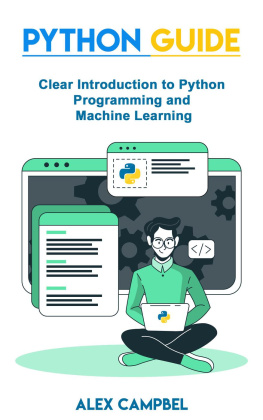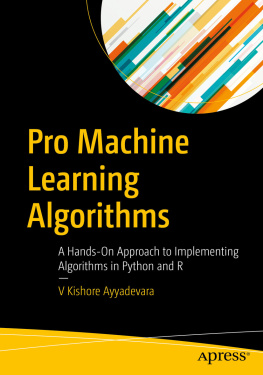Machine learning with Python
The Definitive Tool to Improve Your Python Programming and Deep Learning to Take You to The Next Level of Coding and Algorithms Optimization.

Copyright 2021 All rights reserved
The content contained within this book may not be reproduced, duplicated or transmitted without direct written permission from the author or the publisher.
Under no circumstances will any blame or legal responsibility be held against the publisher, or author, for any damages, reparation, or monetary loss due to information contained within this book. Either directly or indirectly.
Legal notice
This book is copyright protected. This book is only for personal use. Y ou cannot amend, distribute, sell, use, quote or paraphrase any part, or the content within this book, without the consent of the author or publisher.
Theory is when you know everything but nothing works. Practice is when everything works but no one knows why. In our lab, theory and practice are combined: nothing works and nobody knows why.
( Albert Einstein )
Table of Contents
Introduction
Machine learning is a computer program that will learn without being explicitly programmed.
Example:
You train a computer to recognise cats and dogs in images. You give examples of images of cats and dogs. You tell the computer that the cats are on the left side of the images and the dogs are on the right side.
Once you've done that, the computer creates some rules that distinguish cats and dogs.
Tests, where the computer can tell the difference between cats and dogs and can't tell the difference in other images, will be run. These tests will show that the computer is learning and its new rules are better than the ones it had at the start.
What Happens When you Try to Teach a Machine to Do Mathematics?
After a few years of training the machine, the only things the computer can do reliably are some elementary things like creating the rules of the game of chess. He best methods that we can follow and focus our time on when it comes to Machine Learning include:
Logistic Regression
Uses a neural network to produce a complex logistic regression system.
Decision Trees
Uses a set of rules to identify a specific tree that classifies the data into a pre-defined set of classes, e.g. a tree that classifies X people into 2 groups, e.g. either black or white.
Naive Bayes
Artificial Neural Networks
Run on a computer, they have a set of nodes and a list of weights for each node which is stored and fed into the system along with the data. The nodes are connected to each other in some way, which is held in the model, and it uses that to see if it falls into a certain category or perspective. This approach often produces more non-linear results than logistic regression systems.
Co-Regression Models
A set of predictive models that can be used to build generalizations of data sets.
Clustering Algorithms
Data can be categorized into groups, e.g. computers can be grouped into departments, each department having a group of students. An algorithm, such as k-means clustering, uses the data to create the groups that result in the best performance.
Why Python and Data Science?
Python is a very powerful and easy-to-use programming language that can be used for many things. It is easy to move on to other things if you get stuck.
Is it Possible to Apply Machine Learning to Aspects of Mathematics?
Yes. Mathematics involves the manipulation of symbols (like numbers and letters). Data sets can be manipulated. Computers can manipulate data.
Can MATLAB in a Computer Do Machine Learning?
No. MATLAB is a very limited programming language, and it is only suitable for very specific things. People use MATLAB because they want to do those things it is good at.
Is it Possible to Use MATLAB in a Computer to Do Machine Learning?
Yes. It is possible to install MATLAB on a computer, install some libraries and modules to use MATLAB to do Machine Learning tasks, or install a C++ compiler so that the MATLAB program can be modified to do Machine Learning tasks.
How Do You Teach a Computer to Do Machine Learning?
There are many ways to teach a computer to do Machine Learning, and the best way will largely depend on the problem that needs to be solved. As a rule, a computer will need lots of examples of something for it to learn from. In Machine Learning, a computer will need examples of the data it is trying to classify and to predict. The best data set is from a data set that is at least as large as the data set that the computer will be predicting from.
Can You Automate Machine Learning?
Yes. Once a computer is taught how to do a Machine Learning task, it is possible to automate that task. Many websites run competitions that run Python scripts that perform Machine Learning tasks. Python on websites is usually written like an entry to a competition. Competition can be run any time there is a problem where a machine is needed to learn a problem and produce an output.
Do Computers Ever Make Mistakes?
Machines are logical and follow the rules they are given. They do not use judgement or language to solve problems. The answers produced are subject to the rules that it has been given.
Who Is to Blame When a Machine Makes a Mistake?
No one can be to blame when a machine makes a mistake. A machine cannot be to blame. A machine can only follow the rules that are given to it.
Relation Between Big Data and Machine Learning (ML)
Big Data is the data too complex and scattered in such a way, that it needs special algorithms and methodologies to process them, so that they can be properly analyzed. The traditional processing system cannot analyze extremely large volumes of data. Machine learning is a refined type of class of algorithms that will process big data. The algorithms like predictive analytics, Text algorithms, Social network mining, etc., play an important role in the Machine Learning process. Machine learning algorithms are based on the algorithms which are capable of analyzing large volumes of data, structured or unstructured. The process to use ML is to prepare the data by cleaning the data to prepare it for the machine learning algorithms, and train the machine learning algorithms to perform the algorithm by making effective combinations of the machine learning algorithms, pre-processing the data to form the input for the machine learning algorithms, passing the output obtained to the Machine Learning algorithms, and training them to perform the function. The ultimate objective is to obtain the best result in the best time, and these are achieved by creating effective algorithms.
Uses of Machine Learning
The applications of Machine Learning include real-time decisions, clinical medicine, fraud detection, search engine results, and oil analysis to name just a few.
Implementing Machine Learning is a very powerful way of making predictions using the algorithms that follow. The algorithms developed have constantly provided better predictions over time so that the performance of the machine learning algorithms is constantly improving.
The predictive power of those algorithms also enables them to be useful in a wide range of areas. The machine learning algorithms will work in all data types including text, images, audio, social media, and financial market data.




